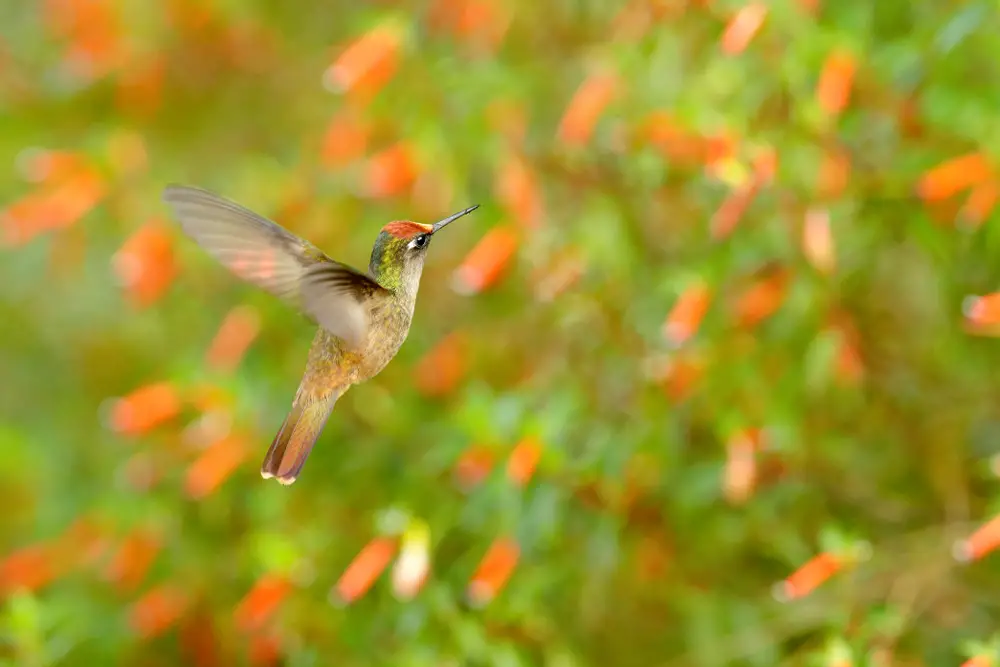With over 361 species of hummingbirds in the world population, there is many hummingbirds to account for. Some species are considered common, while others are critically endangered. This guide has images of hummingbirds that are considered endangered for easy identification.
Threatened species are divided into three categories which include: vulnerable, endangered, and critically endangered. If you spot any of the hummingbirds in these categories, support this population by implementing conservation tactics in your environment. Use this guide to know how to keep your local and endangered species safe. And then, there are also extinct hummingbird species.
It is an honor to see these endangered hummingbirds in person, and its great when you can see photos of them as well. Imagine how lucky the photographers must have felt when taking these shots. Let’s get into the details of what “endangered” means and what we can do about the decreasing numbers of these beautiful hummingbirds. And of course, we are going to admire some rare photos!
Table of Contents
List of threatened hummingbirds
List of threatened species of hummingbirds, according to The International Union for conservation of nature (IUCN):

10% chance of becoming extinct in the next 10 years (vulnerable):
- Santa Marta Blossomcrown (Anthocephala floriceps)
- Hook-billed Hermit (Glaucis dohrnii)
- Black Inca (Coeligena prunellei)
- Pink-throated Brilliant (Heliodoxa gularis)
- Honduran Emerald (Amazilia luciae)
- Purple-backed Sunbeam (Aglaeactis aliciae)
- Mexican Woodnymph (Thalurania ridgwayi)
- Esmeraldas Woodstar (Chaetocercus berlepschi)
- Buffy Helmetcrest (Oxypogon stuebelii)
- Tolima Blossomcrown (Anthocephala berlepschi)
- Tapajos Hermit (Phaethornis aethopygus)
- Ecuadorian Piedtail (Phlogophilus hemileucurus)
- Dry-forest Sabrewing (Campylopterus calcirupicola)

20% chance of becoming extinct in the next 10 years (endangered list):
- Royal Sunangel (Heliangelus regalis)
- Sapphire-bellied Hummingbird (Amazilia lilliae)
- Scissor-tailed Hummingbird (Hylonympha macrocerca)
- Glow-throated Hummingbird (Selasphorus ardens)
- Mangrove Hummingbird (Amazilia boucardi)
- Marvelous Spatuletail (Loddigesia mirabilis)
- Oaxaca Hummingbird (Eupherusa cyanophrys)
- Colorful Puffleg (Eriocnemis mirabilis)
- Black-breasted Puffleg (Eriocnemis nigrivestis)
- Violet-throated Metaltail (Metallura baroni)
- Perija Metaltail (Metallura iracunda)
- Grey-bellied Comet (Taphrolesbia griseiventris)
- Perija Starfrontlet (Coeligena consita)
- Venezuelan Sylph (Aglaiocercus berlepschi)
- Glittering Starfrontlet (Coeligena orina)
- Black-backed Thornbill (Ramphomicron dorsale)
- Long-tailed Woodnymph (Thalurania watertonii)

50% chance of becoming extinct in the next 10 years (critically endangered):
- Chilean Woodstar (Eulidia yarrellii)
- Turquoise-throated Puffleg (Eriocnemis godini)
- Santa Marta Sabrewing (Campylopterus phainopeplus)
- Short-crested Coquette (Lophornis brachylophus)
- Juan Fernandez Firecrown (Sephanoides fernandensis)
- Guanacaste Hummingbird (Amazilia alfaroana)
- Gorgeted Puffleg (Eriocnemis isabellae)
- Blue-bearded Helmetcrest (Oxypogon cyanolaemus)
- Blue-throated Hillstar (Oreotrochilus cyanolaemus)

Extinct species of hummingbirds:
- The Caribbean Emerald (Chlorostilbon elegans)
- the Brace’s Emerald (Chlorostilbon bracei)
Are hummingbirds endangered?
There are many species of hummingbirds worldwide. But even if there are lots of them, their number are still decreasing dramatically by the year. About 10% of hummingbirds are endangered– not a small percentage— and 60% are in decline. Conservation efforts keep failing these pollinators, but luckily the issue is at least being acknowledged and discussed. The reasons why hummingbirds can die are varied.
Many hummingbirds die in the first days of their life while they’re still little birds. There are many circumstances that can put a baby hummingbird in danger from poor weather conditions, to low food supply, and the threat of predators. Moreover, it’s essential to specify that some species of hummingbirds are more endangered than others. So why are these beautiful tiny jewels at the risk of extinction? Well, many factors can explain the decline in the hummingbird population. We are going to talk about the primary ones:
Loss of habitat
The main reason for decreased hummingbird numbers is habitat loss due to urbanization and agricultural practices. When humans make space for new infrastructure they fail to take of survey of what resources they are removing for the surrounding animals that depend on the habitat for nourishment and survival. Thus, hummingbirds can lose access to the natural habitats they frequently visit and depend on, and the easy access to the food they desperately need. Therefore, nectar availability seems to decline more and more.
Climate change
Climate change has a significant impact on these tiny birds as well. For example, this study notes how minute changes in the weather has caused some natural environments to alter the availability of hummingbird food sources, thus affecting the Berryline hummingbird (Amazilia beryllina) and the Dusky hummingbird (Phaeoptila sordida) populations amongst a few others:
“A. beryllina and C. sordidus could lose their local populations in the south and the mountainous part of central Mexico, without having possible sites of expansion towards the north. Even though A. beryllina will show an important reduction in its area of distribution, particularly in the mountainous zones, C. sordidus could be the most effected species of those analyzed since its original distribution exists within the tropical dry forest, one of the most threatened forests of the world.”
Potential effects of the climate change in the distribution of hummingbirds: a study case with hummingbirds from the genus Amazilia and Cynanthus – The Neotropical Ornithological Society 2012
Because of these climate issues, their food supply and migration patterns are severely affected. Hummingbirds are small birds with an extremely fast metabolism (not to mention they’re long-distance migrators); they need to eat more than they weigh so a scarce food supply is not an option for them.
Since their migration routes are becoming unpredictable, they might be forced to stay in harsher conditions, unable to travel to warmer places. The only way to fight this off (at least a little) is for people to help them have more access to nectar by putting hummingbird feeders in their backyards and by also conserving the natural habitats that they may live among. Individuals can attempt to create a habitat environment that would benefit this species, like planting tubular plants.
Pesticides and insecticides
The chemicals you can find in pesticides, fertilizers, and other garden products can be highly damaging to hummingbirds because they can be very toxic for them and the insect life they depend on. Not using chemical pesticides like “Round-up” or landscaping and removing the natural brush and plant-life is another method of conservation.
Pesticides and insecticides will kill a hummingbird’s primary food source: small insects and thus affect the local population of hummingbirds in your area. Opt for a more friendly alternative to pest control, like the use of natural predators, or natural substances like vinegar or a cayenne pepper mist.
Predators
Another reason why the number of hummingbirds is decreasing is the presence of predators; These can be pets like cats and dogs, as well as other bigger birds like hawks and owls. The best alternative is here is if you perceive a threat, try to change the scenario that could be putting the hummingbird in danger. Keeping pets indoors during the time that hummingbirds are visiting your garden or feeding station, and periodically changing the area of your feeder.
Other reasons
Some factors can impact hummingbirds on a large scale (like the ones mentioned above). Others have a minor impact, but it’s essential to be aware of these other factors, too, as they can have a snowball effect:
- Poorly cleaned feeders
- Window collisions
- Extremely cold weather
- Extremely hot weather
How can we help hummingbirds?
If you still want to see this bird flying around in your garden, impressing you with their incredible skills, there are a couple of things you can do:
- Plant red tubular flowers that are perfect for a hummingbird’s long bill
- Put out hummingbird feeders filled with sugar water (homemade nectar made from 1 part sugar to 4 parts water)
- Keep the bird feeders clean at all times – and clean them more often when the weather is hot.
- Don’t use pesticides ad insecticides – instead, look for organic methods to get rid of unwanted visitors.
- Support organizations that fight for habitat conservation – either by donation or by spreading the word
- Keep an eye out for predators and ensure your pet has other distractions inside or outside your home.
- Make your garden hummingbird-friendly by placing other things like perches, bird baths, or sprinklers outside.
Common hummingbird species
There are over 360 hummingbird species worldwide, and you might’ve even heard about some of them before. Some of the most common species of hummingbirds include:
- Anna’s hummingbirds
- Ruby-throated hummingbirds
- Rufous hummingbirds
- Calliope hummingbird
- Allen’s hummingbirds
- Costa’s hummingbird
- Broad-tailed hummingbird
- Broad-billed hummingbird
- Mexican violetear (Colibri thalassinus)
- the bee hummingbird – The smallest hummingbird in the world
- the Giant hummingbird – The biggest hummingbird in the world
- Fiery-throated hummingbird
- White-necked Jacobin Hummingbird
- Chestnut-breasted Coronet Hummingbird

